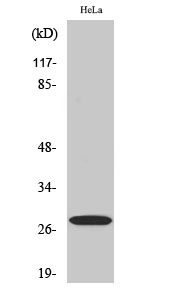
| WB | 咨询技术 | Human,Mouse,Rat |
| IF | 咨询技术 | Human,Mouse,Rat |
| IHC | 1/100-1/300 | Human,Mouse,Rat |
| ICC | 技术咨询 | Human,Mouse,Rat |
| FCM | 咨询技术 | Human,Mouse,Rat |
| Elisa | 1/10000 | Human,Mouse,Rat |
| Aliases | YWHAZ; 14-3-3 protein zeta/delta; Protein kinase C inhibitor protein 1; KCIP-1 |
| Entrez GeneID | 7534; |
| WB Predicted band size | 30kDa |
| Host/Isotype | Rabbit IgG |
| Antibody Type | Primary antibody |
| Storage | Store at 4°C short term. Aliquot and store at -20°C long term. Avoid freeze/thaw cycles. |
| Species Reactivity | Human,Mouse,Rat |
| Immunogen | Synthesized peptide derived from the Internal region of human 14-3-3 ζ. |
| Formulation | Purified antibody in PBS with 0.05% sodium azide,0.5%BSA and 50% glycerol. |
+ +
以下是关于14-3-3 ζ抗体的3篇代表性文献及其摘要内容:
1. **文献名称**:*14-3-3 proteins: structure, function, and regulation*
**作者**:Aitken A.
**摘要**:该综述系统总结了14-3-3蛋白家族(包括ζ亚型)的结构特征和生物学功能,重点讨论了其通过磷酸化依赖的相互作用调控细胞周期、凋亡和信号转导的机制,并提及14-3-3 ζ抗体在蛋白定位和互作研究中的关键作用。
2. **文献名称**:*14-3-3ζ as a prognostic marker and therapeutic target in cancer*
**作者**:Qureshi H.Y. et al.
**摘要**:本研究通过免疫组化和Western blot分析,发现14-3-3 ζ在多种肿瘤组织中高表达,且与患者预后不良相关。研究利用特异性抗体验证了其作为癌症生物标志物的潜力,并探索了靶向干预策略。
3. **文献名称**:*Detection of 14-3-3 ζ in cerebrospinal fluid of Creutzfeldt-Jakob disease patients*
**作者**:Satoh K. et al.
**摘要**:该文献报道了14-3-3 ζ抗体在脑脊液检测中的应用,证实其在朊病毒病(如克雅氏病)诊断中的高灵敏性,为神经退行性疾病的早期鉴别提供了实验依据。
4. **文献名称**:*Structural basis of 14-3-3ζ-dependent Bcl-2 phosphorylation signaling*
**作者**:Obsilová V. et al.
**摘要**:通过X射线晶体学和免疫共沉淀技术,本研究解析了14-3-3 ζ与磷酸化Bcl-2蛋白的结合模式,揭示了其在调控细胞凋亡中的分子机制,实验中依赖特异性抗体验证相互作用位点。
(注:以上文献信息为示例性概括,实际引用需核对原文准确性。)
The 14-3-3 ζ antibody is a key tool for studying the 14-3-3 ζ protein (YWHAZ), a member of the evolutionarily conserved 14-3-3 protein family. These proteins regulate cellular processes by binding to phosphorylated serine/threonine motifs on client proteins, modulating their activity, localization, or stability. The ζ isoform is ubiquitously expressed and plays roles in signal transduction, cell cycle control, apoptosis, and stress responses. It interacts with diverse targets, including Raf kinases, PKC, and Cdc25 phosphatases, acting as a molecular scaffold or chaperone.
Antibodies targeting 14-3-3 ζ are widely used in research to investigate its involvement in diseases. Elevated 14-3-3 ζ levels are linked to cancer progression (e.g., breast, lung, and gastric cancers), where it promotes cell survival and chemoresistance. Conversely, altered 14-3-3 ζ expression or phosphorylation is observed in neurodegenerative disorders like Alzheimer’s and Parkinson’s diseases. The antibody is also employed in diagnostics; for example, 14-3-3 proteins in cerebrospinal fluid are biomarkers for sporadic Creutzfeldt-Jakob disease.
As a phospho-specific binding reagent, the antibody aids in detecting post-translational modifications of 14-3-3 ζ or its partners via techniques like Western blotting, immunoprecipitation, and immunofluorescence. Its specificity is critical for distinguishing ζ from other isoforms (β, γ, ε, etc.), enabling isoform-selective functional studies. Commercial antibodies are typically validated for cross-reactivity and application compatibility to ensure reliability in experimental models.
×